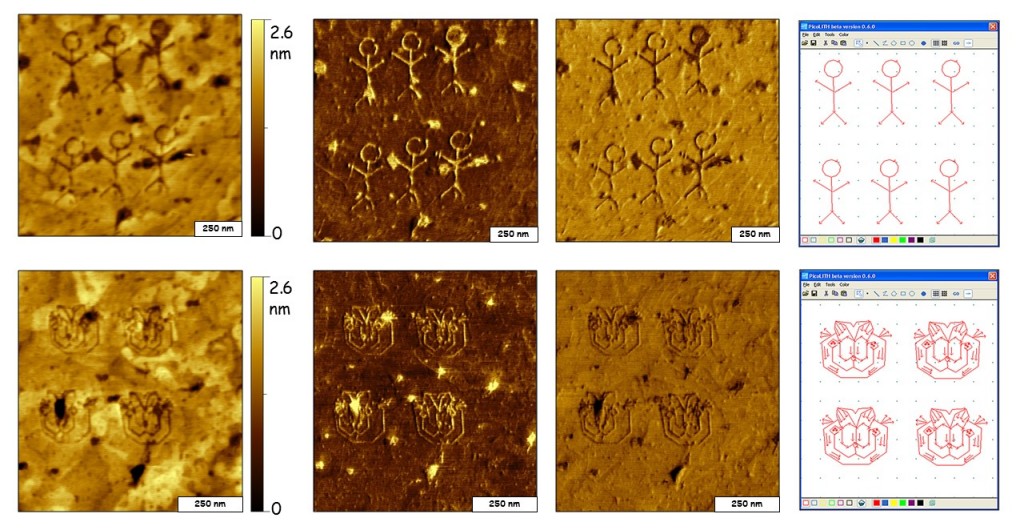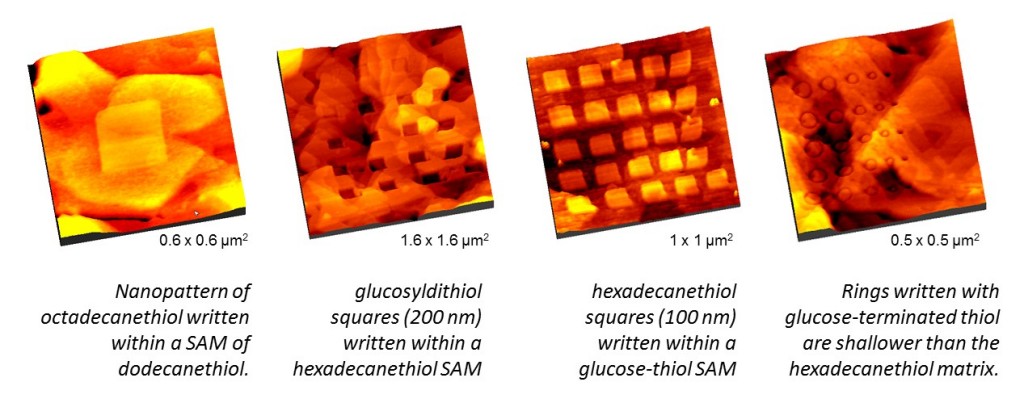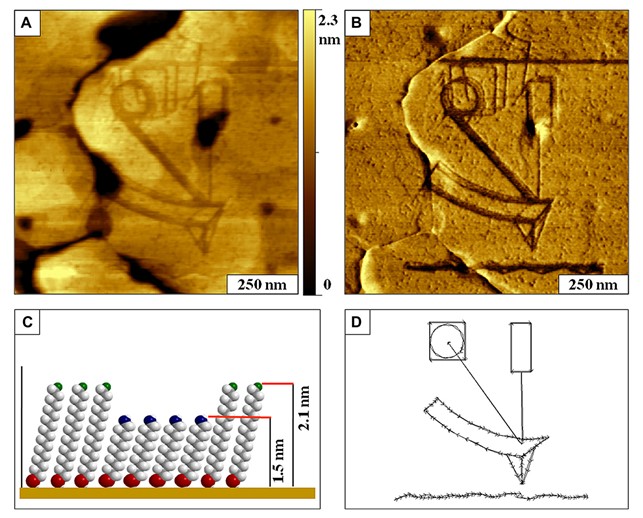Scanning Probe Lithography
 Examples of nanopatterns prepared using scanning probe lithography. The background
areas are an n-alkanethiol matrix on gold, and the nanopatterns were inscribed with an AFM tip operated
in liquid. The images are AFM topographs acquired in ethanol.
Examples of nanopatterns prepared using scanning probe lithography. The background
areas are an n-alkanethiol matrix on gold, and the nanopatterns were inscribed with an AFM tip operated
in liquid. The images are AFM topographs acquired in ethanol.
Scanning probe lithography (SPL) with n-alkanethiol self-assembled monolayers
Nanoscale lithography can be accomplished with SPM experiments to control the design, placement and size of nanostructures for surface measurements. Nanopatterns can be written within organic thin films with sizes in the range of tens of nanometers. With scanning probe-based nanolithography, the chemistry of the nanopatterns can be defined by selecting molecular lengths and endgroups of the molecules chosen for patterning.
Nanoshaving
For nanoshaving, both the tip and sample are submerged in clean solvent for writing nanopatterns. To accomplish writing, the force applied to the AFM probe is increased (0.5-30 nN) to sweep molecules away from the surface. Exposed areas of gold substrate are uncovered by the sweeping action of the tip. The motion and force applied to the tip can be programmed to make designs along the trajectory of the scanning probe.

Nanografting
For nanografting, both the tip and sample are submerged in dilute solutions containing the ink molecules selected for writing. First, the surface is characterized under low force (less than 1 nN) to identify a flat area for nanofabrication (left). Under low force the sample can be characterized without modifying the surface. To accomplish writing, the force applied to the AFM probe is increased (0.5-30 nN). Under high force, the tip is pushed through the matrix monolayer to shave away selected areas, and ink molecules from solution immediately assemble onto the surface following the scanning track of the AFM tip (center). The same probe can then be used for imaging the SAM nanopatterns by returning to a low force setpoint (right).

With nanografting, the choice of molecules will determine whether the nanopatterns are shorter, taller, or the same height as the matrix monolayer. Computer automation enables infinite capabilities for designing shapes, letters and arrangements of surface patterns. The interfacial chemistry can be designed by choosing molecular head groups, such as methyl, hydroxyl, carboxylic acid, etc. The nanopatterned surface can be treated with further addition steps to define the arrangement of proteins, nanoparticles or other molecules.

Design of AFM instrument configuration nanografted with alkanethiols on a gold substrate
 A nanoscale atomic force microscopy (AFM) instrument diagram written with 11-mercaptoundecanol
within an octadecanethiol self-assembled monolayer (SAM). (A) Contact mode AFM topograph
for a 1 × 1 μm2 scan area; (B) corresponding lateral force image; (C) molecular model showing height
differences between the pattern and matrix monolayer; (D) design used for nanografting.
A nanoscale atomic force microscopy (AFM) instrument diagram written with 11-mercaptoundecanol
within an octadecanethiol self-assembled monolayer (SAM). (A) Contact mode AFM topograph
for a 1 × 1 μm2 scan area; (B) corresponding lateral force image; (C) molecular model showing height
differences between the pattern and matrix monolayer; (D) design used for nanografting.
Brown, T. T.; LeJeune, Z. M.; Liu, K.; Hardin, S.; Li, J.-R.; Rupnik, K.; Garno, J. C. Automated scanning probe lithography with n-alkanethiol self-assembled monolayers on Au(111): Application for teaching undergraduate laboratories. (featuring undergraduate work) Invited by the Analytical Systems Digital Library (ASDL). Young Scientist Award from the Association for Laboratory Automation. Journal of the American Lab Association, 2011, 16, 112-125.